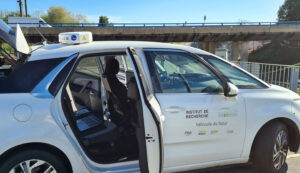5G Mobix aims to assess the contribution of 5G (fifth generation network) to connected and automated mobility services in cross-border conditions. Over the course of the last few years an international collaboration in 5GMobix cross-border trials has been establishing an interconnected, low latency and autonomously-focused future. Fifty-nine partners based in eleven different countries have combined to conduct trials to assess the 5G capabilities for CCAM (Cooperative Connected and Automated Mobility).
Autonomous driving has received widespread attention in recent years, however this hasn’t intrinsically combined connectivity external to the car until now. Offering speeds 200 times faster than 4G and with capabilities of transmitting ultra-HD & 3D video the enhanced platform 5G provides for innovation is crystal clear. What 5G MOBIX will enable is autonomy in transportation which has never been seen before!
Cooperative, Connected and Automated Mobility (CCAM) in its fully autonomous form establishes a vehicle that is connected to the surrounding roads and infrastructure as well as other road users. Imagine a future where autonomous driving technology is empowered by a less than one millisecond latency coupled with seamless handover between multiple networks. In this scenario, the next generation of CCAM will flourish. The Satellite Applications Catapult is proud to be part of this revolutionary journey innovating for a more advanced and sustainable future.

As 5G cellular connectivity grows from the initial roll out stages to expansion everywhere by 2030, high throughput and a low latency in data transmission needs to be prioritised. These two success parameters are essential for future growth in autonomous transport. 5G MOBIX encompasses an international collaborative effort coordinating the following aspects: two cross-border corridors, six pre-deployment trial sites and international cooperation with China & South Korea.
Currently, the average cellular user crossing a border will experience a transfer of Mobile Network Operator (MNO) with a delay between one provider’s connection dropping and the other MNOs signal talking over according to the roaming agreements. This issue is exacerbated by blackspots which are all too common in cellular infrastructure. Transport technology, coupled with current and future infrastructure, is intended to operate in a seamless manner underpinned by ubiquitous networking. This data handover from the moving vehicle must prioritise session continuity – if the data switch does not occur the vehicle will not be able to stay connected for a long distance.
The challenge of seamlessly switching the application server and host providing it refers to where the application is connected to a server – this could be a MEC (Multi access edge computing) server, cloud server or even a central server to the internet. An autonomous car could change network but continue to use the same server, however this would make the data transfer slower and exhibit an unsatisfactory latency. The connection could change to another server but then the application would have to deal with changing network and server. A loss of server connection, even momentarily, could cause a big disruption and would not be ideal for CCAM use cases. The challenge for effective deployment in this project, is making all of this possible with only millisecond delay. The MEC saves data from having to travel thousands of kilometres when it is destined to come back to the same place. MEC is like providing a small local cloud physically installed within geographical proximity. It is this proximity that enables a future where vehicles can transmit information to each other at exceptionally fast speeds. By using MEC technology, a cellular operator can efficiently deploy new services for specific customers or classes of customers. MEC technology also reduces the signal load of the core network and provides a solution for autonomous transport latency requirements.
The Spanish and Portuguese Cross Border Corridor (CBC)
Prior to deployment, key technology was developed and tested in Westcott at the Future Networks Development Centre. Vedecom and the Catapult have been working closely to shape solutions and analyse how satellite connectivity can aid 5G connections across borders. The development has been undertaken and assessed in Westcott (UK) as well as at Vedecom’s French site.
One of the two CBCs of the 5GMOBIX project is the border connecting the cities of Vigo and Porto. The cross-border corridor looked primarily into the challenges of seamless interoperation among the different countries and carriers in both public and private networks. The main CCAM service continuity test establishes where development for an autonomous future can originate from.

In March, Panos Mystridis from the Satellite Applications Catapult along with colleagues from Vedecom visited the Spanish and Portuguese CBC. As the 5G Network Software Engineer, Panos was primarily involved with two stages of testing conducted to evaluate and ensure future CBC data continuity. The primary test conducted was 5G multiple mobile operator connectivity via the multi-SIM modem. Using an intelligent routing device, Panos and the team tunnelled data back to Westcott and Vedecom’s data centre in France. This was to replicate the public to the private network. The configuration solves cellular coverage issues by enhancing the coverage in combining multiple operators to the end user device but is also applicable to emerging private to public network handover too. Panos and the team verified whether a device connected to a private network will remain connected and maintain the data session while moving to a public network with minimum or no packet loss – critical in autonomous driving applications. Spanning a 5-kilometre distance, the engineers travelled back and forth monitoring the data transmission rates via commercial network management software. The initial test provided the foundation of data on the CBC.
The second CBC test included the Thales satellite antenna using the Iridium network. Utilising the Iridium Certus network, the connection can achieve download speeds of 700Kbps with a latency between 600-700ms, future hope of this latency reducing further will massively aid CCAM use cases. In conjunction with intelligent routing, the second solution enables satcom connectivity to bridge the gap between the 5G infrastructure. The main challenges to overcome are two-fold: session continuity and service continuity. The challenge of continuity is switching the attached gateway while maintaining the session; minimum data loss and latency must be maintained for the use cases to be effectively adopted. The satellite provides high availability and redundancy from current 5G connectivity dropping out in between base stations. Proving connectivity is there continually is paramount, although a higher latency will be expected. In 2019 the Iridium constellation completed an upgrade, Iridium Next. This unique mesh architecture of 66 cross-linked satellites forms a global network in space. This satellite constellation provides connectivity unlike most others in a Low-Earth Orbit (LEO), approximately 780 kilometres above the Earth, as opposed to geostationary orbit (GEO) which is at about 35,000 Kilometres from the planet. The L-band frequencies utilised provide better transmission in all weathers, even in adverse conditions in the air, over sea and ground, enabling session continuity throughout CBC scenarios.
The consortium has showcased the benefits of 5G connectivity for CCAM use cases through four testing criteria: Advanced Driving, Remote Control, QoS and Extended Sensors. One of the most involved experiments was the use of an autonomous shuttle to cross the border through a bridge in a completely autonomous way. The consortium was also able to show remote driving for the case where obstacles needed the intervention of a human driver. Other services shown were a lane merge and an overtaking manoeuvre as well as the dynamic update of map information.
Autonomous Electric Vehicles (A-EVs) will transport passengers more efficiently with the development of CCAM, reducing the need for drivers and ultimately fossil fuel internal combustion engines. This alone could close one third of the gap needed to limit global warming to two degrees. Businesses will be able to take advantage of 24/7 autonomous fleets, road and driving information will be able to be processed in near real-time, all of which will bring technical insights and market opportunities for CCAM applications.
